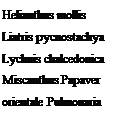The key advantages of planting are that it allows you to establish species that perform poorly when sown as seed in situ and it fast tracks the whole process of creating a vegetation. Most critically, it allows a client to see that something positive has happened. It is, however, important to understand that, in the longer term, interactions between the nature of the site, management and the characteristics of the planted species will determine what species survive. Many species that are initially successful may decline and disappear by year five. Some of the factors that promote this change in species composition are largely independent of choice of planted species, however plant selection remains the key design input in determining long-term outcomes. Information given under the section ‘Establishment by sowing in combination with planting’ on ecological traits of herbaceous plants, plus the effect of soil productivity, soil moisture regime etc., is equally relevant to establishment by planting.
One factor that does differ when establishing naturalistic vegetation by planting is palatability to slugs and snails. Planted herbaceous plants are usually morphologically and physiologically adult, and are generally less palatable to molluscs. This allows the establishment of species that are very palatable as young seedlings, for example Trollius europaeus (Hitchmough 2003), in slug rich sites. Information on the typical palatability of adult herbaceous plants to molluscs in spring is given in Table 6.16. Palatability does, however, vary
|
Table 6.16. Relative palatability of adult herbaceous perennials to molluscs when emerging in spring (derived from the observations of the author)
|
 |
|
Rodgersia
Rudbeckia fulgida var. deamii Sanguisorba Silphium integrifolium Thalictrum
Trachystemon orientale Trollius europaeus Veronica longifolia Veronicastrum
depending upon circumstances. Species that typically escape damage in a traditional plantedborder may be severely damaged when surrounded by dense planting or grasses. This is, for example, the case with typically robust species, such as Astrantia major, Brunnera macrophylla and Cephalaria alpina. Plantings which are shaded for part of the day also suffer more damage. The extent of damage also seems to be inversely proportional to the density of palatable species, and damage to palatable species increases as the proportion of unpalatable species increases in a planting.



